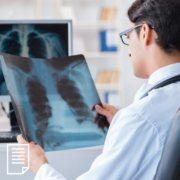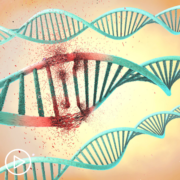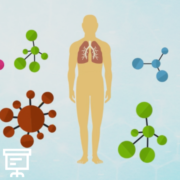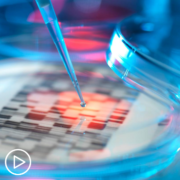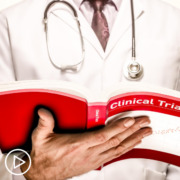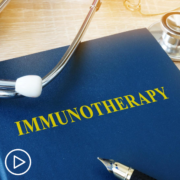How Can You Access Personalized Lung Cancer Treatment? from Patient Empowerment Network on Vimeo.
When facing a lung cancer diagnosis, how do diagnostic tests affect your treatment plan. Dr. Tejas Patil discusses appropriate testing for lung cancer, latest targeted therapies and how emerging research is affecting patient outcomes.
Dr. Tejas Patil is an academic thoracic oncologist at the University of Colorado Cancer Center focused on targeted therapies and novel biomarkers in lung cancer. Learn more about Dr. Patil, here.
Download Program Resource Guide
See More From INSIST! Lung Cancer
Related Programs:
Transcript:
Katherine:
Welcome to Insist! Lung Cancer, a program focused on empowering patients to insist on better care. Today, we’ll discuss the latest advances in lung cancer, including the role of genetic testing and how this may affect treatment options.
I’m Katherine Banwell, your host for today’s program. Joining me is Dr. Tejas Patil. Dr. Patil, would you introduce yourself please?
Dr. Patil:
Sure. Thank you for inviting me to speak on this platform. My name is Dr. Tejas Patil. I am an Assistant Professor at the University of Colorado, where I take care of patients diagnosed with thoracic cancers, which include non-small cell lung cancer, small cell lung cancer, and also include mesothelioma and thymic cancers. My main research focus is on molecular alterations in lung cancer and development of targeted therapies.
Katherine:
Thank you. Before we start, a reminder that this program is not a substitute for seeking medical advice. Please refer to your own healthcare team.
Dr Patil, before we get into an in-depth discussion on lung cancer, would you tell us about the types of lung cancer?
Dr. Patil:
Absolutely. Lung cancer has a bit of a confusing nomenclature. Historically, Lung cancer was divided into small cell lung cancer and non-small cell lung cancer, and this distinction was based on how the lung cancer appeared under a microscope, but it also has practical implications. Small cell lung cancer tends to have a very different biology than non-small cell lung cancer. It originates from neuroendocrine cells and is treated very differently than non-small cell lung cancer.
Non-small cell lung cancer is also a bit of a misleading term because it really is a catch-all term. It represents a wide group of histologies that are not small cell lung cancer. So, basically, anything that isn’t small cell lung cancer will be non-small cell lung cancer, but that group is very heterogenous and includes subtypes like adenocarcinoma, squamous cell carcinoma, adenosquamous, large cell and even sarcoma type variance.
Distinguishing between the two is important because the prognosis and treatment options are actually very different between small cell and non-small cell lung cancer.
Katherine:
Well, let’s talk about testing and diagnosis. Following a diagnosis, are there specific tests that patients should ask their doctor for?
Dr. Patil:
Right. After a diagnosis of lung cancer has been made, the most important next step is to establish a cancer stage, and so this is typically done through the TNM staging criteria. The T typically reflects the size of the tumor. The N reflects whether there’s lymph nodes involved with cancer and the M refers to whether there’s a metastasis, and metastasis refers to whether the cancer has spread outside of the lung.
Based on a combination of scores using the TNM criteria, lung cancers are staged from one to four. Now, to establish these different scores, oncologists will typically request varieties of scans. These include CT scans, PET CT scans, MRI and in some cases, very sophisticated ultrasound techniques called endobronchial ultrasound, so that’s the staging component. I think, in addition to the staging component, once a patient has a diagnosis of lung cancer, the tissue itself can be subject to a variety of different molecular tests which we will cover in this talk.
Katherine:
Well, let’s get into the tests. How are each of these tests administered?
Dr. Patil:
Well, first let’s discuss imaging.
Staging is a very important component of lung cancer, and at minimum, a patient should have a CT scan of the chest and abdomen with extension down to the adrenal glands. The reason for this is that this type of imaging, at least the extent of the imaging, will cover most of the metastatic sites that lung cancer tends to go towards. Additionally, a PET CT scan can be obtained.
Now, a PET scan is a very unique form of imaging. Patients will receive a radio labeled form of glucose and the principle of a PET scan is that since cancers metabolize glucose, which is sugar at a higher rate than normal tissue, the scan in principle helps clinicians identify spots where cancer could be. One important point about imaging and this is something patients should be aware of, is that lung cancers are unique cancers in that there’s a very high risk of spread to the brain.
And so, as part of baseline staging, almost every patient with lung cancer should be getting an MRI of the brain to rule out brain metastases.
Then a final point I’ll make is that patients with Stage 2 or 3 lung cancer really should have their cases reviewed in a multi-disciplinary context where there’s input from surgeons, pulmonologists, medical oncologists, and radiation specialists because the treatment for Stage 2 and 3 lung cancer can be quite complicated. I think, and we’ll talk about the – so, that was the staging part. Now, we can talk a little bit more about the diagnostic testing and molecular testing specifically.
There’s been tremendous advances in lung cancer. One of the biggest advances has been the appreciation that there are very specific mutations that actually “drive” cancers that cause them to grow, divide and metastasize.
We call this mutation an oncogene. Over the past two decades, there have been many oncogenes in lung cancer that have been identified. Interestingly several of these oncogenes, such as the ALK mutation, or the EGFR mutation, tend to occur in patients who were never smokers.
So, while smoking is the major environmental risk factor for lung cancer, our understanding of these, through molecular testing has identified a group of patients who were never smokers yet still developed lung cancer. The reason this is important to know is that there’s a variety of targeted therapies available for patients who do have mutations such as ALK or EGFR, and these are typically associated with very favorable outcomes in lung cancer.
Katherine:
What are common lung cancer mutations, first of all?
Dr. Patil:
There are many mutations that are found in lung cancer. I should mention that the scope of what mutations we find very much depends on the type of molecular test that’s performed. This is a topic that’s beyond the scope of this discussion, but know that when you say you are getting genetic testing, a lot of that depends on the genes that are in the test, meaning if a molecular test is only looking for 10 genes, or 10 mutations, it’s only going to pick up 10 mutations versus more comprehensive molecular testing, which look at hundreds or even thousands of genes, will identify more mutations.
That being said, there are approximately 10 mutations currently for which there are targeted therapies, either that are commercially licensed through the FDA, or are being evaluated in the context of the clinical trial.
And in patients who are heavy smokers, the most common mutation that we see that’s an oncogene is a KRAS mutation, and there’s currently drugs in clinical trials that are looking to target a very specific KRAS mutation.
Dr. Patil:
In never smokers, the mutation spectrum is actually quite a bit more varied, and here, we see mutations such as ALK, EGFR, ROS1, RET, MET, HER2 and BRAF.
I want to make a quick point that there’s another biomarker that we use in lung cancer that’s not technically a mutation, per se, but it’s very important for clinicians to obtain, and that’s called a PD-L1 score. This is a score that helps clinicians decide how effective immunotherapy can be in a certain patient.
Katherine:
Are some mutations more common than others?
Dr. Patil:
Yes. I mean, there are mutations that are very common. I think to answer that question a little bit more in this cleanly, I would say that there are some mutations that are very common in lung cancer such as TP53, but these are mutations where we can’t actually, we don’t have a targeted approach to manage them. So, when I refer to common mutations, I’m talking about mutations where I either have a drug that is available and able to target the mutation, and this drug is being either investigated in a clinical trial, or is commercially licensed.
In lung cancer, the most common oncogene would be KRAS, and there, there’s a couple of exciting clinical trials where there are some promising drugs in development for treating this specific mutation which has been very challenging to treat in lung cancer.
Katherine:
How is genetic testing for lung cancer different from hereditary genetic testing?
Dr. Patil:
That’s a great question. We have learned that there are several cancers, such as breast and colorectal cancer, where there’s clear evidence that there are hereditary genes that increase an individual’s risk for developing cancer. I personally prefer the term molecular testing over genetic testing as this emphasizes that we’re looking for specific mutations that are really acquired during a patient’s lifetime and typically not inherited.
Katherine:
How do genetic mutations in lung cancer affect treatment options for patients?
Dr. Patil:
Well, the finding of a molecular alteration, or an oncogene, is really important for a patient with lung cancer because it offers a unique class of therapy that the patient would not have had otherwise. Finding a mutation is important because it allows patients to have treatment options outside of traditional chemotherapy or immunotherapy.
Katherine:
Dr. Patil, how do targeted therapies work?
Dr. Patil:
Targeted therapies are interesting. They work by specifically targeting and blocking specific mutations in lung cancer, and so it’s kind of like a lock and key model. By blocking the binding site of a mutation, the treatment actually prevents that cancer cell from properly functioning, and this in turn causes the cancer cell to be unable to divide, unable to grow, and ultimately results in cancer cell death. Targeted therapies typically come in either a form of a pill.
That’s the most common way that patients take targeted therapies.
As an aside, I will note that there’s a very unique class of targeted therapies called antibody-drug conjugates. These are really fascinating molecules. They are treatments that are consistent, but very complex, bioengineered structures, so what you have is an antibody that targets some protein on the surface of a cancer cell, a mutation.
This antibody is linked to a chemotherapy payload, and so it allows for very potent chemotherapy to be delivered effectively and selectively to cancer cells, sort of like a Trojan Horse effect where the antibody finds the cancer cell, goes inside the cancer cell, and once the whole structure is inside the cell, that’s when the chemotherapy is released.
Therefore, it’s a way of giving chemotherapy in a more targeted way, and there are several of these in clinical trials right now.
Katherine:
Well, you mentioned patients taking pills. What other treatment regimens are there for the targeted therapies?
Dr. Patil:
For targeted therapies, the most common is a pill. The schedule depends on the mutation, so it can sometimes be once a day or twice a day. And then, there are IV treatments that we see, and that is the antibody drug conjugate that I’m referring to where patients will have to go to a infusion center to get those. But to my knowledge, most of those are still in the context of a clinical trial, and so I think it’ll be a while before we start seeing them commercially licensed.
Katherine:
How do the newer therapies differ from the more traditional chemotherapy?
Dr. Patil:
Chemotherapy is still an important tool in an oncologist’s arsenal.
It works by killing, or rather it works by affecting a cancer cell’s ability to divide and grow. The logic here is that since cancer cells typically grow faster than normal cells, chemotherapy is more likely to kill cancer cells. It should be noted that while that is true, there are certain cells in the human body that grow very quickly as well, such as hair follicles, the lining of the mouth, and cells within the bone marrow. And so, as a result, it’s very common that the side effects of chemotherapy typically affect these cells, so you typically see hair loss. You see mucositis, or inflammation of the mouth, diarrhea, and low blood counts, and this a general side effect of chemotherapy.
Katherine:
Are there common side effects for some of the newer therapies as well?
Dr. Patil:
That’s a great question and the way I’m going to answer that is it depends on the mutation that the targeted therapy’s affecting. So, a mutation that I’m going to use as an example is a mutation called EGFR. Now, this is a mutation that we see in lung cancer that causes cancer cells to grow, divide, and metastasize.
But EGFR is interesting because it also is found in normal cells, and specifically it’s found in the cells of the skin and the gut lining. This is an example where you’re giving a very targeted therapy that’s trying to attack just the cancer cell, but because normal skin cells and gut cells have this EGFR receptor, the side effects there tend to be rash and diarrhea. Now, that’s unique to EGFR. There are other drugs such as the ALK mutation or the ROS1 mutation that do not have this side effect because that specific receptor is not found in the human body.
Katherine:
Oh, I see. Well, how is the effectiveness of treatment monitored?
Dr. Patil:
Typically, I have the philosophy that patients generally know their body and can tell when symptoms are getting better or worse. So, as a guiding principle, I rely on patient input very heavily. That being said, I corroborate that experience with some testing. In my practice, I frequently use what we call serum tumor markers, so these are very nonspecific-like tests that sort of let us know if there’s cancer type proteins in the blood that we can detect while they are on targeted therapy.
And then additionally I would recommend that patients get scans frequently, at the minimum every three months if they are on targeted therapy and doing otherwise well. That includes a CT scan of the chest and abdomen, and in certain cases, an MRI of the brain, if there were brain metastases before.
Katherine:
Is it necessary to retest at any time?
Dr. Patil:
This is a good question and it’s an evolving question. In general, I strongly advocate that patients who are on targeted therapies obtain additional molecular testing after they’ve progressed, and the reason is the following. Cancer cells evolve resistance mechanisms to overcome targeted therapies and understanding these resistance mechanisms can be quite helpful in designing next lines of treatments.
A very good example of this is in EGFR lung cancer. The very first type of targeted therapy for EGFR positive lung cancer was a drug called Erlotinib. What we had seen was that when patients were on this drug, Erlotinib, they would respond, and they would do really well for a period of time.
But after a period of time, patients would progress on this therapy, and a very common mutation that we would find, once they progressed was a mutation called T790M. By biopsying this patient and finding this mutation, it was very helpful because it allowed the medical community and researchers to investigate a new drug called Osimertinib, which can overcome that resistance mutation.
And we’re learning a lot about resistance pathways and resistance mutations in lung cancer, so I think it’s very important that patients who are on targeted therapies specifically get retested and re-biopsied.
Katherine:
Let’s move on then. Dr. Patil, what are you excited about in lung cancer research right now?
Dr. Patil:
I thought ASCO 2020 this year was a very exciting cancer conference, and I’m very excited about where lung cancer research is going. I think there are two areas to be very hopeful about.
First, is that there have been several oncogenes or mutations that we had known about for a very long time, but there was just no targeted therapy available. I think in the next several years, you’re going to start to see more and more targeted therapies available for patients who have otherwise rare mutations.
And examples of this would include KRAS G12C, RET, Met and HER2, so this is very exciting because these were mutations that we had known about for a long time, but just until more recently really haven’t had any successful therapy for.
The other area that’s very exciting is that we’re starting to see the use of targeted therapy and immunotherapy in patients who have earlier stage cancer. So, there was a lot of talk this ASCO about using targeted therapies in patients who have, for example, Stage 3 lung cancer, and is there a benefit in doing that? I think that’s going to be a very interesting development of patients who have Stage 1 to 3, which we typically treat with curative intent, how do we make sure that they improve their outcomes and really stay cured?
Katherine:
Right. What would you say to patients who are nervous about participating in a clinical trial?
Dr. Patil:
That’s a great question. I really appreciate you asking that. In general, I would highly recommend patients consider clinical trials. I think there’s a couple of things to point out. It’s very important to remember that clinical trials are evaluating novel therapies as compared to current standard best practice. So, placebos are rarely used in cancer research unless there’s no known effective therapy. It’s important to remember, it’s not ethical to have someone take placebo if there’s known treatment that work, so when a patient enrolls in a clinical trial, sometimes they don’t know which treatment they’re getting, but at least they will know that whatever treatment they’re getting is the best current standard of care.
I want to also point out that clinical trials really answer, in my mind, two important questions. The first question is, is the new treatment safe? And does the new treatment work better than current standard of care? These are really important questions for advancing the field, especially in cancer research. Clinical trials are a small part of the research. I mean, when a drug that’s getting introduced into a clinical trial, it’s sometimes helpful to think about all the investment that has gone in before them. The drug has to be discovered, created.
It has to be purified, tested in animal studies, before it ever reaches human studies. And so, there’s only the most promising agents are actually ever introduced at clinical trials, and there’s a lot of data to show that the biggest barrier for completing clinical trials, and therefore understanding which treatments are effective, is really participant enrollment.
I think there was a recent study that showed that about, I think less than five percent of patients, less than 1 in 20, with cancer will ever take part in a clinical trial, Therefore, if a patient has that opportunity, I would strongly encourage them to consider it.
Katherine:
Do you think a second opinion is necessary? Would you encourage patients to consult with another specialist?
Dr. Patil:
In general, I’m a big advocate that patients should get all the information they need to make informed treatment decisions, and if that involves getting second opinions, I welcome that.
I think that a knowledgeable patient is an empowered patient, and certainly a knowledgeable patient is one that I think will be able to guide themselves through a very complex medical journey. So, in general my philosophy is I’m always encouraging of second opinions if the patient feels that they need more information to make a best decision.
Katherine:
What advice do you have for patients who may be hesitant to speak up and advocate for themselves when it comes to their care and treatment?
Dr. Patil:
Great question. In general, I’m a big believer that an empowered patient is a patient that can make really good medical decisions as they navigate their own medical journey. Ultimately, it’s important for patients to be knowledgeable and seek multiple opinions. Really get the best advice, so that they make the best decisions. Oncology is a very complicated field. The treatment options can be very nuanced.
Therefore, it’s important to know that when a decision is presented to a patient, that it is a decision that is made with the knowledge of what is the best standard of care. But if the patient doesn’t feel like they have the most informed data to guide their own medical decision making, then it’s really important for them to advocate for themselves.
To that point, especially for some of these rarer mutations, there are many social media patient advocacy groups that are very, very, very well organized, very effective, and have a list of really useful questions. Some examples of that are the ALK Positives and the EGFR Resisters.
Katherine:
Okay. I would be remiss if we didn’t discuss COVID-19 to some extent. What should lung cancer patients be considering at this time?
Dr. Patil:
This is also a very important and timely question. lung cancer patients are certainly at very high risk of complications from COVID-19. And it’s understandable, especially given the kinds of treatments that patients with lung cancer receive, that there’s a lot of them will wind up having compromised immunity which makes them at increased risk for adverse outcomes from COVID-19. That being said, I think it’s really important that this be balanced with the actual risk of untreated or inadequately treated lung cancer, which is also a major medical concern. What I tell patients is that, at least at our institution, we do everything we can to create an environment that is as safe as possible from a COVID mitigation standpoint.
But at the end of the day, untreated lung cancer can have a very aggressive course, and so making sure that patients understand that as we try to move things to a more telemedicine type approach, that there are some things where you really just have to come and see your doctor. Not everything can be done virtually.
Katherine:
Right, and my next question was is telemedicine the best approach right now?
Dr. Patil:
Well, that’s also, I’m going to answer that in a somewhat frustrating way, which is that there’s – yes and no. I think telemedicine is helpful for patients who have very stable disease and are on anti-cancer treatment, so specifically a patient on targeted therapy, for example.
A pill once a day. Their last scans show that they’re doing really well. They feel well. They’re exercising every day. That patient, probably we can do a visit virtually and just make sure and check in that there’s nothing new or concerning that’s come up.
The other patient that probably I can see a role for telemedicine is someone who had, let’s say, a Stage 1 lung cancer that was treated with surgery, and we’re just monitoring them on surveillance. That patient probably doesn’t have to come into the clinic to see us. But in general, the thing about lung cancer is that most patients are getting some kind of chemotherapy or immunotherapy and will be coming into an infusion center, and so what I would tell patients is if there’s any new or concerning symptoms, to a very low threshold for seeking an in-person evaluation.
Katherine:
As a researcher in this field, Dr. Patil, what do you want to leave the audience with? Are you hopeful?
Dr. Patil:
I’m very hopeful. I think, it’s kind of amazing when I look at the history of lung cancer and where the field was in the 2000s, now that we’re in 2020, and what remarkable advances have been made in 20 years. It’s worth reminding patients that in 2000, there was, platinum chemotherapy was the first line for metastatic lung cancer, and then there was a second line chemotherapy and that was basically it. Now we’re in an era where we have extensive molecular testing of lung cancer. We’re identifying new mutations that can be targeted with very sophisticated pill-based therapies. We have immunotherapy. We’re learning about how these combine with each other to produce the most optimal outcomes, so I think in 20 years a lot has been achieved, and I’m really excited to see where we go from here.
Katherine:
Dr. Patil, thank you so much for joining us today.
Dr. Patil:
Thank you. Thank you for inviting me. This was wonderful.
Katherine:
And thank you to all of our partners.
To learn more about lung cancer, and to access tools to help you become a more proactive patient, visit www.powerfulpatients.org. I’m Katherine Banwell.



